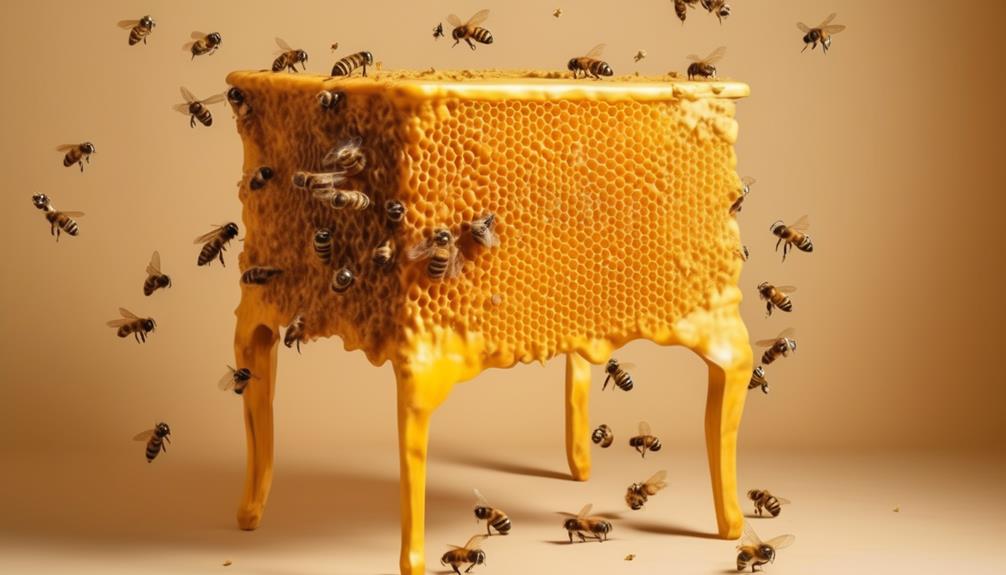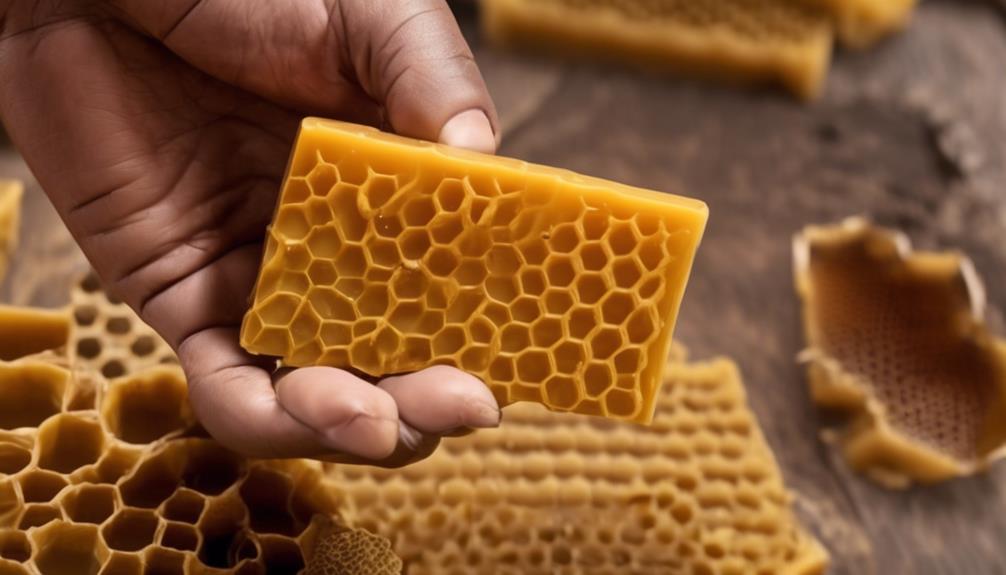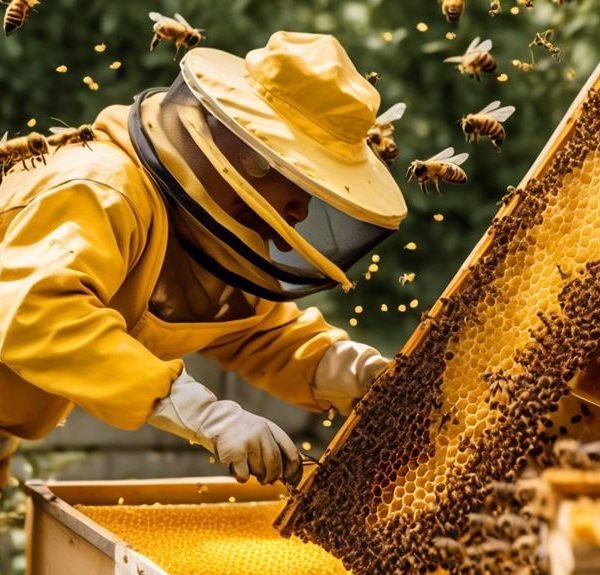Discover the simple steps to using beeswax on furniture, enhancing its beauty and longevity, in our comprehensive guide.

How Do You Use Beeswax on Furniture?
You might think that using beeswax on furniture is a laborious and time-consuming task, but don't let that deter you. With the right approach, it can be a straightforward process that leaves your furniture looking not just clean, but also richly polished and protected.
Beeswax is a natural product, revered for its ability to nourish wood and bring out its innate beauty.
So, what is the most effective way to use beeswax on furniture, you ask? Well, let's explore this further and by the end of it, you'll be eager to get started.
Key Takeaways
- Beeswax enhances the appearance of furniture and provides a beautiful, long-lasting shine.
- Using beeswax on furniture increases its longevity and creates a protective barrier against spills and stains.
- Sourcing quality beeswax can be done through local sources like farmers' markets, health food stores, and apiaries, as well as online platforms like Amazon and eBay.
- Proper preparation of furniture, such as removing dust and dirt, inspecting for imperfections, and potentially sanding the surface, is necessary before applying beeswax.
Understanding the Benefits of Beeswax

Often underestimated, beeswax offers a myriad of benefits for your furniture, enhancing not only its appearance but also its longevity. It's a natural product that doesn't contain the harsh chemicals found in many commercial furniture polishes. This means it's safer for you and your family, while still delivering a beautiful, long-lasting shine.
Applying beeswax to your wooden furniture isn't just about aesthetics. It also creates a protective barrier against spills and stains, helping your pieces withstand the rigors of daily use. Over time, this can significantly extend the life of your furniture, saving you cash in the long run.
Beeswax is also known for its nourishing properties, feeding the wood and preventing it from drying out and cracking. This is especially beneficial in drier climates or during the winter months when indoor heating can create a parched environment for your furniture.
Sourcing Quality Beeswax for Furniture

Knowing the benefits of beeswax, you might be wondering where to find high-quality beeswax for your furniture. The good news is, it's not as challenging as you might think. Whether you're in a bustling city or a quiet town, you can source beeswax both locally and online.
Locally, check out farmers' markets, health food stores, or apiaries. They often sell beeswax products sourced directly from beekeepers. It's a solid option if you prefer supporting local businesses and enjoy the opportunity to ask about the beeswax's origin.
If you prefer shopping online, there are numerous reputable suppliers. Websites such as Amazon and eBay have a wide selection of beeswax products. When buying online, it's crucial to read product descriptions and reviews to ensure you're getting quality beeswax.
When choosing beeswax, look for pure, unbleached products. It should have a natural, honey-like aroma and a golden-yellow color. If it smells artificial or looks overly processed, it's likely not high quality.
Preparing Your Furniture for Beeswax Application

Before you can start applying beeswax to your furniture, it's crucial to properly prepare the surface to ensure a smooth and successful application. Begin by removing any dust or dirt from your furniture using a clean, dry cloth. Don't overlook the corners and crevices – dust tends to accumulate in these areas.
Next, inspect your furniture for any scratches or imperfections. If you find any, consider lightly sanding the surface with fine-grit sandpaper. This will smooth out any rough spots and create an ideal surface for the beeswax.
After sanding, wipe down your furniture again to remove any residual dust. If your furniture has a previous finish, such as varnish or lacquer, you'll need to remove it before applying beeswax. You can do this with a suitable furniture stripper, following the product's instructions carefully.
Step-by-step Guide: Beeswax Application Process

Once your furniture is dust-free, sanded smooth, and stripped of any previous finish, you're ready to get started with the beeswax application process.
First, you'll need a clean cloth – lint-free and soft. Dip it into your beeswax, gathering a small amount. Less is more here; you don't want to oversaturate the wood.
Next, apply the beeswax to your furniture in a circular motion. This helps to ensure even coverage. Work in small sections, allowing the wax to penetrate the wood's surface. Don't rush. This process should be slow and methodical for the best results.
Once you've covered the entire piece, let the wax sit for about 15 to 20 minutes. This gives it time to penetrate deeper into the wood, providing a protective layer and a beautiful sheen.
Maintaining Beeswax-Coated Furniture

To keep your beeswax-coated furniture looking its best, you'll need to perform regular maintenance, which primarily involves gentle cleaning and periodic reapplication of beeswax. Start by dusting the furniture lightly with a soft, dry cloth. For deeper cleaning, use a mild soap solution, but be careful not to soak the wood. Dry it promptly to prevent moisture-related damage.
Regarding the reapplication of beeswax, you'll need to pay attention to the condition of the finish. If the wood starts to look dry or dull, that's your cue. Don't rush the process though; reapplication is typically needed only once or twice a year. To reapply, follow the same steps you used when you first applied the wax: clean the surface, apply a thin layer of beeswax, let it dry, and then buff it well.
Frequently Asked Questions
Can Beeswax Be Used on All Types of Wood Furniture?
Yes, you can use beeswax on all types of wood furniture. It's a natural product that's safe and effective for preserving and enhancing the look of your pieces.
Just make sure you've cleaned the surface thoroughly, then apply a thin layer of beeswax with a soft cloth. Buff it in circular motions and let it dry.
You'll see your furniture's natural beauty shine through, no matter what type of wood you're working with.
How Frequently Should Beeswax Be Reapplied to Furniture?
You should reapply beeswax to your furniture every six months to a year, depending on usage and exposure to sunlight. If your furniture sees a lot of wear and tear, or is in a sunny spot, you'll want to wax more often.
Is Beeswax Safe to Use on Furniture if I Have Pets or Children?
Yes, beeswax is safe to use on furniture even if you've got pets or children. It's a natural product that won't harm them if they happen to ingest it. However, it's always best to let it fully absorb and dry before letting them near the furniture.
Are There Any Health Risks Associated With Using Beeswax on Furniture?
Generally, there aren't any health risks associated with using beeswax on furniture. It's natural, non-toxic, and safe even if you have pets or children.
However, as with anything, it's possible to have an allergic reaction to beeswax. If you're concerned, try a small amount on a hidden piece of furniture first to see if there are any adverse reactions.
Also, always ensure you're using pure beeswax, as some products may add harmful chemicals.
Can Beeswax Be Used on Furniture That Is Painted or Varnished?
Absolutely! You can use beeswax on painted or varnished furniture. It's a great way to add a layer of protection and shine.
Just remember to test a small, inconspicuous area first to ensure it doesn't discolor your paint or varnish.
Apply a thin layer of beeswax with a cloth, let it dry, then buff it out.
It'll give your furniture a lovely, natural sheen and help keep it looking its best.
Conclusion
So, you've learned the ropes of using beeswax on furniture. It's a great, natural choice that not only enhances the look of your pieces, but also extends their life.
Don't forget to source quality beeswax and prep your furniture correctly. Following the steps carefully ensures a successful application.
With proper maintenance, your beeswax-coated furniture will stay looking its best for years.
Now, go on, give it a try – your furniture will thank you!


